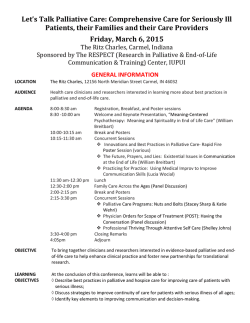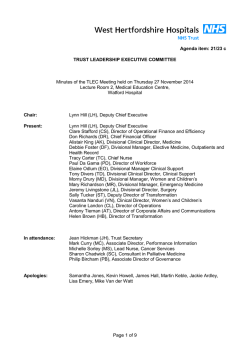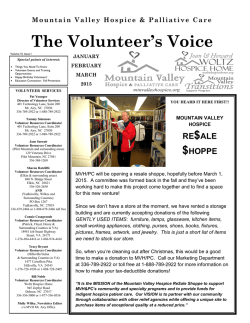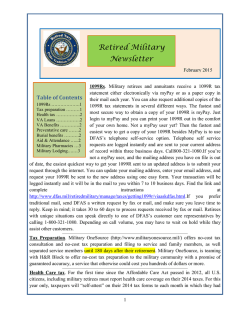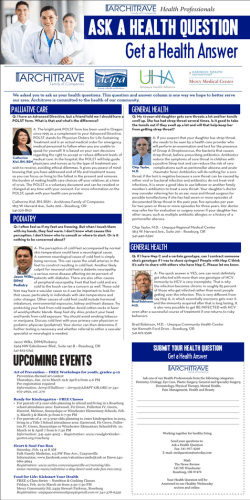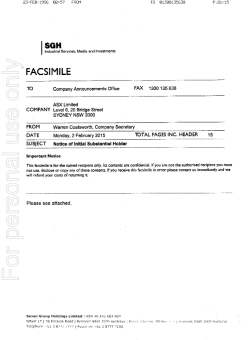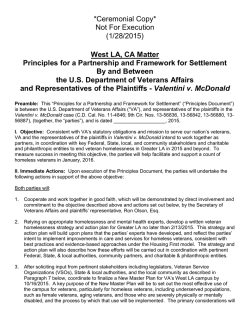
Download the complete issue (PDF 314 KB)
Media Watch... is intended as an advocacy, research and teaching tool. The weekly report is international in scope and distribution – to colleagues who are active or have a special interest in hospice and palliative care, and in the quality of end-of-life care in general – to help keep them abreast of current, emerging and related issues – and, to inform discussion and encourage further inquiry. 2 February 2015 Edition | Issue #395 Compilation of Media Watch 2008-2015 © Compiled & Annotated by Barry R. Ashpole The illness experience: Scroll down to Specialist Publications and '"You only have one chance to get it right": A qualitative study of relatives' experiences of caring at home for a family member with terminal cancer' (p.12), in Palliative Medicine. Canada Hospital on-call compensation program Proposed plan to help Windsor's dying could be shelved without government funding ONTARIO | The Windsor Star – 29 January 2015 – Failed contract negotiations between Ontario's doctors and the province have jeopardized plans to improve fragmented palliative care programs in Windsor hospitals, say physicians. Windsor Regional Hospital, last fall, asked the ministry of health to help fund a comprehensive palliative care program that is expected to cost $565,000 for its first year of operation. The proposal relies heavily on additional money to pay specialized on-call physicians who need to be available 24-hours a day. But when the province imposed a contract on [the province's] doctors earlier this month, part of that deal included a freeze on the hospital on-call compensation program. With that decision, the hopes of getting $150,000 to pay for specialized physicians to be on-call disappeared. Without the physicians, the program doesn't work, according to Dr. Darren Cargill, one of Windsor's palliative care doctors. Existing palliative care programs in Windsor are funded by the province, through the Erie St. Clair Local Health Integration Network [LHIN]. But Windsor Regional has, at best, a patchwork of mixed services that need improvement, according to a proposal submitted to the LHIN board... http://blogs.windsorstar.com/news/proposed-plan-to-help-windsors-dying-could-be-shelvedwithout-government-funding Noted in Media Watch, 1 December 2014, #386 (p.1): ONTARIO | The Windsor Star – 28 November 2014 – 'Home-care services still threatened, despite injection of new funding.' Despite an influx of several million dollars into home-care funding, services in the region will still be reduced. Patients have been on high alert for the past few weeks after the Erie St. Clair Community Care Access Centre (CCAC) revealed a massive deficit, which it planned to make up by cutting home nursing visits by 33%... http://blogs.windsorstar.com/news/home-care-services-still-threatened-despite-injection-ofnew-funding Cont. pg. 1 Noted in Media Watch, 24 November 2014, #385 (p.2): ONTARIO | The Windsor Star – 20 November 2014 – 'Salaries of top positions at CCAC rise despite home care service cuts.' Over the past five years, the number of salaries higher than $100,000 at Erie St. Clair CCAC has more than doubled. In 2008, there were 9. In 2013, 21. Funded by the Ministry of Health & Long Term Care, Erie St. Clair CCAC is meant to provide and co-ordinate home care for vulnerable sectors of the population... http://blogs.windsorstar.com/news/salaries-of-top-positions-at-ccac-rise-despite-service-cuts U.S.A. Dying shouldn't be so brutal THE NEW YORK TIMES | Online – 31 January 2015 – Our health care system is well honed to fight disease, but poorly designed to meet the basic safety needs of seriously ill patients and their families. We can do both. We must People who are approaching the end of life deserve the security of confident, skillful attention to their physical comfort, emotional well-being and sense of personal dignity. Their families deserve respect, communication and support. Exemplary health systems and healthy communities deliver all of this today. But they are few and far between. Since 1997, the Institute of Medicine has produced a shelf of scholarly reports detailing the systemic dysfunctions, deficiencies and cultural blinders that make dying in America treacherous. Most people want to drift gently from life, optimally at home, surrounded by people they love. Epidemiological and health service studies paint an alarmingly different picture. An American living with cancer has a roughly one in four chance of dying in a hospital and a similar chance of spending a portion of his or her last month in intensive care. The chances are higher with chronic lung or heart disease. An American with Alzheimer's disease will very likely spend most of his or her last months in a nursing home, yet many long-term care facilities are woefully understaffed and ill equipped to care for demented people. Less than 45% of dying Americans receive hospice care at home, and nearly half of those are referred to hospice within just two weeks of death. Hospice was designed to provide end-of-life care, but this is brink-of-death care. Dying is not easy, but it needn't be this hard. http://opinionator.blogs.nytimes.com/2015/01/31/dying-shouldnt-be-sobrutal/?hp&action=click&pgtype=Homepage&module=c-column-top-span-region®ion=ccolumn-top-span-region&WT.nav=c-column-top-span-region&_r=0 Of related interest: THE ATLANTIC | Online – 25 January 2015 –'The fallacy of "giving up."' ...in the 1940s, almost everyone died at home. But by the late 1980s, a mere 17% of people did. That shift was partly due to tremendous scientific advances that transformed the hospital from a place of very few effective treatments, to a place that had intravenous antibiotics, heart surgery, and kidney transplantation. By the latter part of the century, a doctor could do something for almost anyone (or rather, almost any medical condition), and hospitals became places not of resignation, but of hope. In 1946, the Hill-Burton Act provided government funding for widespread hospital construction. For the moderately and seriously ill, going to a hospital became the default. And so people died fighting. They died fighting even when the fight was futile. They died on sterile wards with electrodes taped to their chests and tubes in orifices both natural and manmade. They died deprived of sleep and good food and all things familiar. They died in uniform gowns, whose singular purpose is accommodation of gastrointestinal processes. And worst, they died the way they most likely wouldn't have wanted to die. The dilemma of modern medicine, in the era of tremendous medical capabilities – when almost any person can be kept alive well past the point when they would have otherwise died (in some cases, after they did die) – is when are health professionals missing the point? When does care become ... torture? http://www.theatlantic.com/health/archive/2015/01/dying-better/384626/ pg. 2 Doctors as advocates for family leave THE NEW YORK TIMES | Online – 29 January 2015 – More than 30 million families are shouldering the significant health care demands of an ill loved one. Some are fortunate enough to live in one of the handful of states ... that have paid family leave or earned sick time laws that allow workers to earn a portion of their pay while taking time off to address the health needs of a family member. Most families, however, must rely on the 1993 Family & Medical Leave Act, a law that guarantees 12 weeks of parental or sick leave but covers little more than half of all workers and does not include pay. As a result, a significant number of working adults end up ... in an exhausting juggling act, running between the critical daily care for an ill family member and the iron-clad demands of a job they cannot afford to give up, even temporarily. Nonetheless, the debate over expanding such laws has been fierce. And up until recently its most vocal proponents and opponents have been labor experts, economists, politicians and women and family rights advocates. Their arguments have been focused on productivity, costs, admin- istrative burdens, fairness and global competitiveness while ignoring, strangely enough, the very reason for any debate at all.http://well.blogs.nytimes.com/2015/01/29/ doctors-as-advocates-for-familyleave/?ref=health&_r=0 Extract from The New York Times article Doctors and other health care providers can do more, by acting as patient advocates and supporting broader family leave policies. Specialist Publications '"You only have one chance to get it right": A qualitative study of relatives' experiences of caring at home for a family member with terminal cancer' (p.12), in Palliative Medicine. 'Family carers providing support to a person dying in the home setting: A narrative literature review' (p.12), in Palliative Medicine. Of related interest: WYOMING | The Star Tribune (Casper) – 28 January 2015 – 'Bill allows Wyoming hospice providers to assist long-term caregivers.' The one-page bill creates a significant change in Wyoming's health care industry by allowing hospices to help long-term caregivers find time for vacations or simply a day off from an often stringent job. http://trib.com/news/state-andregional/govt-and-politics/bill-allows-wyoming-hospice-providers-to-assist-long-termcaregivers/article_19942dbc-e880-5007-8770-eef28db488ab.html Veterans Affairs steps up programs as more veterans enter hospice care NATIONAL PUBLIC RADIO | Online – 28 January 2015 – Starting last year, more military veterans are passing away in hospice care than in all of Veterans Affairs trauma and ICU wards combined. That's because the millions of Americans who served in Korea [1950-1953] and World War II [1941-1946] are reaching their 80s and 90s; Vietnam veterans are reaching their 70s. That means the U.S. Department of Veterans Affairs is focusing on how to make them comfortable in their final weeks and months. http://www.npr.org/blogs/health/2015/01/28/381938804/va-stepsup-programs-as-more-veterans-enter-hospice-care Of related interest: NATIONAL PUBLIC RADIO | Online – 28 January 2015 – 'End-of-life care can be different for veterans.' Caring for veterans isn't always the same as caring for others: as veterans approach the end of life, old traumas can resurface or appear for the first time. http://www.npr.org/2015/01/28/382218316/end-of-life-care-can-be-different-for-veterans Cont. pg. 3 Selected articles on hospice and palliative care in Veterans Health Administration facilities noted in past issues of Media Watch: JAMA SURGERY | Online – 24 September 2014 – 'Use of palliative care and hospice among surgical and medical specialties in the Veterans Health Administration.' Surgical patients are less likely to receive either hospice or palliative care in the year prior to death compared with medical patients... [Noted in Media Watch, 6 October 2014, #378 (p.12)] http://archsurg.jamanetwork.com/article.aspx?articleid=1906152 U.S. DEPARTMENT OF VETERANS AFFAIRS | Online – 11 August 2014 – 'Evaluation of hospice and palliative care in Veterans Health Administration facilities.' Inspectors evaluated hospice and palliative care at 54 facilities... They recommended that the Under Secretary for Health, in conjunction with the Veterans Integrated Service Network and facility leaders, ensure all facilities provide: 1) at least the minimum required Palliative Care Consult Team staffing; and, 2) end-of-life care training to staff who work in areas where they are likely to encounter patients at the end of their lives. [Noted in Media Watch, 18 August 2014, #371 (p.3)] http://www.va.gov/oig/pubs/VAOIG-14-00727-239.pdf JOURNAL OF THE AMERICAN GERIATRICS SOCIETY | Online – 21 March 2014 – 'Bereaved next of kin's suggestions for improving end-of-life care in Veterans Affairs medical centers.' They provided examples that resonated with their conceptions of quality end-of-life care and also situations and perceptions of deficits in care. [Noted in Media Watch, 21 March 2014, #351 (p.8)] http://onlinelibrary.wiley.com/doi/10.1111/jgs.12764/abstract When should I start thinking about hospice care, for myself or a loved one? THE WASHINGTON TIMES | Online – 26 January 2015 – Introduced to the U.S. in the 1970s, hospice care is becoming an increasingly common treatment. Last year, 1.65 million people received hospice care, up from just more than 1 million in 2004, according to the National Hospice & Palliative Care Organization. In the Washington area, more than a dozen hospice providers serve about 2,400 patients daily, according to figures compiled ... in an online consumer guide published as part of a recent investi1 gation into the hospice industry. [See sidebar right.] Although the growth in hospice programs has given patients and their families more choices than ever, the Post probe found widespread concerns about the quality of care citing numerous complaints, noting that although hospices are supposed to provide continuous nursing care to patients whose pain or symptoms are out of control – commonly called "crisis care" – one in seven do not. Unfortunately, there is no federal rating system – as there is for hospitals and nursing homes – that can help consumers make educated choices about the hospice they select. For many families, hospice is an unfamiliar concept that prompts fear and 1. questions, including where, why and even when someone should receive hospice care. http://www.washingtonpost.com/national/hea lth-science/when-should-i-start-to-thinkabout-hospice-care-for-myself-or-a-lovedone/2015/01/26/d5cecf90-8a08-11e4-a08534e9b9f09a58_story.html 'Business of Dying' Each installment in The Washington Post series has been noted in Media Watch. See 15 December 2014, #388, issue of the weekly report (p.4) for a listing to that date. The most recent installment, 'Dying and profits: The evolution of hospice,' is noted in Media Watch, 29 December 2014, #390 (p.3). Specialist Publications 'Viewing hospice decision making as a process' (p.8), in American Journal of Hospice & Palliative Medicine. 'Consumer guide to hospice,' The Washington Post, 18 December 2014. http://www.washingtonpost.com/wp-srv/special/business/hospice-quality/ Cont. pg. 4 Of related interest: THE HUFFINGTON POST | Online – 26 January 2015 – '5 action steps to improve end-oflife care in your community.' Our current abysmal statistics in end-of-life care (70% of Americans say they would prefer to die at home, only 25% actually do) are the result of multilayered issues – societal, cultural, medical, economical, financial, and political in nature. So how can we make a difference? How can we even begin to change such a vast and complex system? The simple answer is to start wherever you are, in your own backyard, so to speak. http://www.huffingtonpost.com/karen-m-wyatt-md/5-action-steps-to-improve_b_6535234.html Church dogma a poor fit for some patients' needs CALIFORNIA | Times-Standard (Eureka) – 24 January 2015 – There are now 56 separate entities that manage 629 Catholic Hospitals. One in six patients in the U.S. is cared for in a Catholic hospital. They employ more than 640,000 full-time staff. Nearly one-third of these facilities are located in rural areas. Since 1994, the U.S. Conference of Catholic Bishops (USCCB) has steadfastly regulated the delivery of health care throughout this extensive system. Their Ethical & Religious Directives for Catholic Health Care Services define a host of restrictive policies. The USCCB enforces them through each diocesan bishop, who exercises the ultimate authority regarding the services that will be allowed in his diocese. The fifth edition of these religious directives issued in 2009 is the most current. The document contains 72 specific directives with theological commentary. Many Catholics and most non-Catholics do not know these directives exist, let alone understand the scope of the restrictions they impose upon all patients, staff and employees of Catholic health systems. Since the impact of these directives greatly affects end-of-life care ... I urge people to become familiar with them. http://www.timesstandard.com/opinion/20150124/churchdogma-a-poor-fit-for-some-patients-needs Respeto. Confianza. Familismo. IDAHO | The Boise Weekly – 28 January 2015 – A living will often read, "If there's nothing you can do to prolong life more than a short while, then I want to be comfortable." That's a very limited document. Maybe they should read, "If my cancer is advanced and I have eight weeks to live with aggressive treatment, or two weeks to live without it, I want to be comfortable." When physicians talk to families about what the patient wants, we use abstractions and talk in terms of medical procedures, and that limits the conversation. http://www.boiseweekly.com/boise/respetoconfianza-familismo/Content?oid=3393878 Specialist Publications 'Use of the Physician Orders for LifeSustaining Treatment Program [POLST] in the clinical setting: A systematic review of the literature' (p.9), in Journal of the American Geriatrics Society. Noted in Media Watch, 6 January 2014, #339 (p.8): HEALTH PROGRESS, January-February 2014. 'The policy debate: Catholic Health Association resources solidly support palliative care.' The Association's public policy positions embrace the importance of providing compassionate care to all people, especially to those facing serious illness – those in pain or those who are dying. Ethical & Religious Directives for Catholic Health Care Services call on Catholic health care organizations to be communities of 1 respect, love and support for patients and their families as they confront the reality of death. http://www.chausa.org/publications/health-progress/article/january-february-2014/the-policydebate-cha-resources-solidly-support-palliative-care 1. Ethical & Religious Directives for Catholic Health Care Services, 5th Edition, United States Conference of Catholic Bishops, 17 November 2009. http://www.usccb.org/issues-andaction/human-life-and-dignity/health-care/upload/Ethical-Religious-Directives-CatholicHealth-Care-Services-fifth-edition-2009.pdf Cont. pg. 5 Noted in Media Watch, 21 March 2011, #189 (p.9): THE HASTINGS REPORT, 2011;41(2):28-29. 'Making sense of the Roman Catholic directive to extend life indefinitely.' In November 2009, the U.S. Conference of Catholic Bishops issued Ethical & Religious Directives for Catholic Health Care Services, requiring that all patients ... be provided with artificial hydration and nutrition if such care could extend life indefinitely. http://www.thehastingscenter.org/Publications/HCR/Detail.aspx?id=5164 Assisted (or facilitated) death Representative sample of recent news media coverage: COLORADO | Fox News (Denver) – 26 January 2015 – '"Dying with dignity" bill to be introduced in Colorado legislature...' The death with dignity law ... [Democratic Representative Lois Court proposes] ... would allow terminally ill patients to choose when to die. The choice would require the approval of two doctors and there will be a mandate for the patient to go through a rigorous application process. http://kdvr.com/2015/01/26/dying-with-dignity-bill-to-beintroduced-in-colorado-legislature-tuesday/ NEW MEXICO | KOB News (Alburquerque) – 25 January 2015 – 'Court of appeals to hear arguments on assisted suicide in New Mexico.' The New Mexico court of appeals will hear arguments on whether a licensed doctor can assist a very ill person in committing suicide. The right to die issue began with Aja Riggs, a woman battling stage 3 cancer with a prognosis that her time to live was limited. Last January, Bernalillo County judge Nan Nash rendered this opinion "This Court cannot envision a right more fundamental, more private or more integral to the liberty, safety and happiness of a New Mexican than the right of a competent, terminally ill patient to choose aid in dying." With that the doors to "physician aid in dying" were opened until the attorney general's office appealed citing important laws like this should be left to the state legislature... http://www.kob.com/article/stories/s3687495.shtml#.VMaRS9LF_YQ CALIFORNIA | The California Report (San Francisco) – 22 January 2015 – 'California Bill would allow terminally ill to end their own lives.' State lawmakers are renewing a call to give terminally ill patients more say over how and when they die. [Democrat] Senators Lois Wolk of Davis and Bill Monning of Santa Cruz have introduced the 'End of Life Option Act.' The bill would allow physicians to prescribe lethal medication to patients who request it. http://blogs.kqed.org/stateofhealth/2015/01/22/california-bill-would-allow-terminally-ill-to-endtheir-own-lives/ N.B. Oregon and the State of Washington enacted legislation to legalize "aid in dying" in 1997 and 2009, respectively. Legislators in Vermont (in 2013) and Montana (in 2008), and judges in Montana (in 2008) and New Mexico (in 2014), authorized it. Besides Washington D.C. and Maryland, "aid-in-dying" legislation is expected to be introduced or debated in at least 15 statehouses. Source: The Washington Post. Barry R. Ashpole My involvement in hospice and palliative care dates from 1985. As a communications consultant, I've been involved in or responsible for a broad range of initiatives at the community, regional, provincial and national level. My current work focuses primarily on advocacy and policy development in addressing issues specific to those living with a terminal illness – both patients and families. In recent years, I've applied my experience and knowledge to education, developing and teaching on-line and in-class college courses on different aspects of end-of-life care, and facilitating issue specific workshops, primarily for frontline care providers. Biosketch on the International Palliative Care Resource Center website at: http://www.ipcrc.net/barry-r-ashpole.php Media Watch Online Media Watch (or a link to the weekly report) is posted on a number of websites that serve the hospice and palliative care community-at-large. Complete listing p.13. pg. 6 International Elder and home care in England Care spend "cut by fifth in decade" U.K. (England) | BBC News – 28 January 2015 – Spending on care for people aged 65 and over has fallen by a fifth in England over the last 10 years, an analysis by the BBC shows. The research ... showed £1,188 was being spent in 2003-2004 per person over the age of 65. By 2013-2014 that had fallen to £951 – a drop of 20% - prompting experts to warn that vulnerable people were being failed. Other parts of the U.K. are also struggling to keep pace with the ageing population. Care refers to everything from support provided in people's homes to round-theclock help in care homes. Unlike the National Health Service, people have to pay towards these services. Some get help from their local authorities, but others pay the full cost of their care. One in 10 people face lifetime costs of over £100,000. About 420,000 people are currently living in care and nursing homes across the U.K., while about 1 million get help in their own home. There are another 1.5 million people who rely on friends and family for support. http://www.bbc.com/news/health-31015807 Extract from BBC News report To work out spending figures that reflected the ageing population and the increasingly complex needs that people have, the BBC compared data from the Health & Social Care Information Centre on funding by councils, and Office for National Statistics population data. Specialist Publications 'Comparative analysis of specialization in palliative medicine processes within the World Health Organization European region' (p.11), in Journal of Pain & Symptom Management. 'Putting palliative care on the global health agenda' (p.12), in The Lancet Oncology. Of related interest: U.K. (England & Wales) | The Daily Mail – 31 January 2015 – 'Indignity, a dearth of compassion, terrible suffering and utter chaos...' A Daily Mail investigation has revealed a catalogue of failings – inadequate training, call times of 15 minutes or even less in which carers must meet their clients' most basic needs; carers asked to be literally in two places at once because they are allocated insufficient travelling time. It all adds up to a grim picture, according to 1 the former care minister Paul Burstow. http://www.dailymail.co.uk/news/article2933902/Indignity-dearth-compassion-terrible-suffering-utter-chaos-investigation-ll-terrifyfamily-lay-bare-agonising-death-Britain-s-home-care-system.html 1. 'Key to Care: Report of the Burston Commission on the Future of the Home Care Workforce,' Local Government Information Unit, December 2014. http://www.lgiu.org.uk/wpcontent/uploads/2014/12/KeyToCare.pdf U.K. (Scotland) | BBC News – 27 January 2015 – 'Care changes: Who will be the winners and losers?' From next April, Scots who have to pay for a place in a care home will find themselves forced to play a game of chance, and the stakes are high. Governments north and south of the border have introduced different policies concerning the cost of care. After April 2016 the difference between Scotland and England will be particularly stark. Under the present system, most people living in Scotland who need social care are winners compared with their counterparts in England. http://www.bbc.com/news/uk-scotland-31003354 Media Watch posted on Palliative Care Network-e Website Palliative Care Network-e (PCN-e) promotes education amongst health care providers in places around the world where the knowledge gap may be wider than the technology gap ... to foster teaching and interaction, and the exchange of ideas, information and materials. http://www.pcn-e.com/community/pg/file/owner/MediaWatch pg. 7 Health care costs in England The "problem" of medical drug prices U.K. | BBC News – 25 January 2015 – A lot of people in the National Health Service (NHS) hate the Cancer Drugs Fund (CDF) – the pot of money dedicated to funding expensive cancer drugs for patients in England. This is because the CDF – a fund that will have £340 million next year – exists to pay for treatments that would not be bought were cancer subject to normal NHS costbenefit rules. Cancer patients are given more support than other patients. This is seen as a problem for two reasons. First, basic fairness. Why care more about cancer than other diseases? Second, it undermines the cost-benefit system that officials and doctors work hard to make work for the rest of the NHS. http://www.bbc.com/news/uk-politics-30974000 Assisted (or facilitated) death Representative sample of recent news media coverage: AUSTRALIA (Queensland) | ABC News – 28 January 2015 – 'Majority of Queenslanders in support of euthanasia.' There is a huge desire among Queenslanders for people suffering from terminal diseases to be legally permitted to die with the help of doctors. That was the message from the latest Vote Compass survey on moral issues. The findings were based on almost 70,000 respondents to the proposition: "Terminally ill patients should be able to legally end their own lives with medical assistance." More than three quarters agreed – 75.9% – with almost half strongly agreeing with people having the right to assisted suicide. http://www.abc.net.au/news/2015-01-28/vote-compass-majority-of-queenslanders-in-supportof-euthanasia/6049750 Specialist Publications (e.g., in-print and online journal articles, reports, etc.) Viewing hospice decision making as a process AMERICAN JOURNAL OF HOSPICE & PALLIATIVE MEDICINE | Online – 29 January 2015 – Research focused on understanding that the nature of hospice decision making has both described the characteristics of those who do and do not utilize hospice and identified many factors related to choosing hospice. However, this literature has not explored the underlying decisionmaking processes, limiting our understanding. The authors examine the extant literature and propose a framework that views hospice decisions as an evolving process, identify key factors that bear directly on this process, and discuss the contextual environment, including the idea of a decision maker triad. They end with a discussion of how this framework can be used to support clinical practice and future research. The authors' goal is to provide a framework from which to understand the end-of-life needs of all patients, no matter where they receive care. http://ajh.sagepub.com/content/early/2015/01/29/1049909115569592.abstract Perspective from Japan How do medical journalists treat cancer-related issues? eCANCER | Online – Accessed 29 January 2015 – The authors sent self-administered questionnaires to 364 journalists in 82 [news] organisations who had reported on medical issues for the Japanese media, asking for their reasons for reporting on cancer-related issues and the difficulties they had faced. The most common reason for reporting on health-related issues was their personal interest in a particular issue. They mainly covered conventional therapies, healthcare policy, new therapies, and diagnosis. All of the journalists that were surveyed experienced some Cont. pg. 8 difficulties in reporting health issues. Significant concerns included the quality of information, social impact, lack of technical knowledge, and difficulty in understanding technical terms. Journalists commonly used personal networks, including physicians, as information sources, as well as social media (e.g., e-mail, Twitter and Facebook). Topic selection was biased, with 35 of 48 journalists having never reported on topics concerning hospices. Physicians were the most trusted source of information about cancer, and journalists attached high importance to interviewing them. As medical knowledge is advancing rapidly, journalists may have increasing difficulty covering cancer-related issues. http://ecancer.org/journal/9/full/502-how-do-medical-journalists-treatcancer-related-issues.php N.B. English language article. Noted in Media Watch, 26 November 2012: CANADA | CBC News (Commentary) – 5 October 2012 – 'Disturbing questions about the incompatibility of science and news.' Science "evolves," but news "happens." As reporters, we want to be able to tell you the 5 Ws, the Who, What, Where, When and Why of the story, with absolute certainty, even though in science it's almost impossible to be eternally certain about anything. http://www.cbc.ca/news/health/story/2012/10/04/f-crowe-studies-false.html Good death for children with cancer: A qualitative study JAPANESE JOURNAL OF CLINICAL ONCOLOGY | Online – 26 January 2015 – Thirteen characteristics including unique and specific for children of a good death were identified: 1) sufficient opportunities to play freely; 2) peer supporters; 3) continued access to the patient's usual activities and relationships; 4) assurance of privacy; 5) respect for the patient's decisions and preferences; 6) a sense that others acknowledge and respect the patient's childhood; 7) comfort care to minimize distressing symptoms; 8) hope; 9) not aware of the patient's own impending death; 10) constant dignity; 11) strong family relationships; 12) no sense of being a burden to family members; and, 13) good relationships with medical staffs. This study identifies important characteristics of a good death for children with cancer. These findings may help medical staffs provide optimal care for children with cancer and their families, enabling them to achieve a good death. http://jjco.oxfordjournals.org/content/early/2015/01/26/jjco.hyu223.abstract N.B. English language article. Of related interest: AJOB EMPIRICAL BIOETHICS | Online – 22 January 2015 – 'Children's hospital ICU nurse and physician rankings of important considerations in pediatric end-of-life decision making.' Nurses and physicians who care for dying children prioritize foremost the child's best interests and comfort, but then possess varying secondary priorities about what is most important when making medical decisions. Pediatric palliative care and ethics consultative services should be aware of and prepared to address these differing concerns. http://www.tandfonline.com/doi/abs/10.1080/23294515.2014.980959#.VM0WldLF_YQ Use of the Physician Orders for Life-Sustaining Treatment Program [POLST] in the clinical setting: A systematic review of the literature JOURNAL OF THE AMERICAN GERIATRICS SOCIETY | Online – 29 January 2015 – Twentythree research studies focused on POLST use in the clinical setting were identified. A majority of studies have been conducted all or in part in Oregon, with chart review the most frequently used methodology. Research suggests that POLST is most commonly used in older, white patients who are near the end of life. A non-physician facilitator usually prepares the POLST form for the physician to review and sign. The orders documented on POLST reflect a wide degree of individualization, with only approximately one-third of patients having orders reflecting the lowest Cont. pg. 9 level of treatment in all POLST form sections. Clinicians have generally positive attitudes regarding use of POLST yet report a wide range of challenges. POLST alters treatment in a way that is consistent with orders. However, evidence that POLST reflects patient or surrogate treatment preferences is lacking. http://onlinelibrary.wiley.com/doi/10.1111/jgs.13248/abstract Selected articles on POLST noted in past issues of Media Watch: ANNALS OF EMERGENCY MEDICINE | Online – 17 April 2014 – 'Physician Orders for LifeSustaining Treatment and emergency medicine: Ethical considerations, legal issues, and emerging trends.' POLST is quickly growing in popularity and prevalence as a method of communicating the end-of-life care preferences for the seriously ill and frail nationwide. [Noted in Media Watch, 28 April 2014, #355 (p.10)] http://www.annemergmed.com/article/S01960644(14)00220-0/abstract THE LINACRE QUARTERLY, 2013;80(2):103-138. 'The POLST paradigm and form: Facts and analysis.' A critical analysis of the risks POLST poses to sound clinical and ethical decision-making with recommendations to help Catholic healthcare professionals and institutions address the challenges of end-of-life care. [Noted in Media Watch, 20 May 2013, #306 (p.13)] http://www.maneyonline.com/doi/abs/10.1179/0024363913Z.00000000027?queryID=33%2F29 1722 Learning about dying, death, and end-of-life planning: Current issues informing future actions JOURNAL OF INTELLECTUAL & DEVELOPMENTAL DISABILITY | Online – 23 January 2015 – Knowing about dying and death is a typical part of lifelong learning, gained through personal experience with the death of loved ones, popular culture, and formal education. Sudden and unexpected death aside, adults in the general community can use this knowledge to plan for the manner of their dying... Such planning might include will making, advance care planning, enduring guardianship, organ donation and, for some, decisions about the where and the how of end-of-life care. People with intellectual disability, however, are not afforded similar opportunities to learn or plan for dying... The aim of this paper is to outline current thinking around the need for people with intellectual disability to learn about and understanding dying and death. http://www.tandfonline.com/doi/abs/10.3109/13668250.2014.998183?journalCode=cjid20#.VM0O n9LF_YR Selected articles on end-of-life care for people living with an intellectual disability noted in past issues of Media Watch: PALLIATIVE MEDICINE | Online – 19 September 2014 – 'Developing a best practice model for partnership practice between specialist palliative care and intellectual disability services: A mixed methods study.' Four themes emerged: 1) challenges and issues in end-oflife care; 2) sharing and learning; 3) supporting and empowering; and, 4) partnership in practice. Joint working and learning between intellectual disability and specialist palliative care were seen as key and fundamental. A framework for partnership practice between both has been developed which could have international applicability and should be explored with other services in end-of-life-care. [Noted in Media Watch, 29 September 2014, #377 (p.5)] http://pmj.sagepub.com/content/early/2014/09/17/0269216314550373.abstract BRITISH JOURNAL OF LEARNING DISABILITIES | Online – 22 September 2014 – 'Surveying community nursing support for persons with an intellectual disability and palliative care needs.' Highlighted were the benefits of liaison between family and professional and nonprofessional carers. [Noted in Media Watch, 29 September 2014, #377 (p.5)] http://onlinelibrary.wiley.com/doi/10.1111/bld.12105/abstract;jsessionid=38C0E8C7CDF052F4 68F9BF41A4D88180.f03t02?deniedAccessCustomisedMessage=&userIsAuthenticated=false Cont. pg. 10 BMJ SUPPORTIVE PALLIATIVE CARE | Online – 29 July 2014 – 'The nature and importance of quality of therapeutic relationships in the delivery of palliative care to people with intellectual disabilities.' Study participants commented on the importance of trust, of continuity of relationship, and of knowing the individual. However, palliative care staff admitted to difficulties in these areas... [Noted in Media Watch, 4 August 2014, #369 (p.8)] http://spcare.bmj.com/content/early/2014/07/29/bmjspcare-2013-000619.abstract PATIENT EDUCATION & COUNSELING | Online – 23 May 2014 – 'Decision making about medical interventions in the end-of-life care of people with intellectual disabilities: A national survey of the considerations and beliefs of GPs, intellectual disabilities physicians and care staff.' Quality of life and wellbeing were also frequently considered in both decisions to start/continue an intervention and decisions to forgo/withdraw an intervention. Seventy per cent believed that people with intellectual disabilities should always be informed about interventions, and 61% would respect a refusal by the person. [Noted in Media Watch, 2 June 2014, #360 (p.10)] http://www.pec-journal.com/article/S0738-3991(14)00194-3/abstract Comparative analysis of specialization in palliative medicine processes within the World Health Organization European region JOURNAL OF PAIN & SYMPTOM MANAGEMENT | Online – 13 January 2015 – In 2014, 18 of 53 countries have official Programs on Specialization in Palliative Medicine (POS-PM): Czech Republic, Denmark, Finland, France, Georgia, Germany, Hungary, Ireland, Israel, Italy, Latvia, Malta, Norway, Poland, Portugal, Romania, Slovakia, and the U.K. Ten of these programs were begun in the last five years. Palliative medicine (PM) is recognized as a "specialty," "subspecialty" or "special area of competence," with no substantial differences between the last two designations. The certification contains the term "palliative medicine" in most countries. Clinical training varies, with one to two years being the most frequent duration. There is a clear trend toward establishing the POS-PM as a mandatory condition for obtaining a clinical PM position in countries' respective health systems. http://www.jpsmjournal.com/article/S0885-3924(15)00043-3/abstract Cont. next page Media Watch: Editorial Practice Each listing in Media Watch represents a condensed version or extract of what is broadcast, posted (on the Internet) or published; in the case of a journal article, an edited version of the abstract or introductory paragraph, or an extract. Headlines are as in the original article, report, etc. There is no editorializing ... and, every attempt is made to present a balanced, representative sample of "current thinking" on any given issue or topic. The weekly report is issue-oriented and offered as a potential advocacy and research tool. Distribution Media Watch is distributed at no cost to colleagues active or with a special interest in hospice, palliative care and end of life issues. Recipients are encouraged to share the weekly report with their colleagues. The distribution list is a proprietary one, used exclusively for the distribution of the weekly report and occasional supplements. It is not used or made available for any other purpose whatsoever – to protect the privacy of recipients and also to avoid generating undue e-mail traffic. Links to Sources 1. Links are checked and confirmed as active before each edition of Media Watch is distributed. 2. Links often remain active, however, for only a limited period of time. 3. Access to a complete article, in some cases, may require a subscription or one-time charge. 4. If a link appears broken or inactive, try copying/pasting the URL into the address bar of your browser or, alternatively, Google the title of the article or report, and the name of the source. 5. Due to its relevance, an article may be listed but for which a link is not available; access, therefore, may only be possible directly from the source (e.g., publication) or through the services of a library. Something Missed or Overlooked? If you are aware of a current report, article, etc., relevant to hospice, palliative care or end-of-life issues not mentioned, please alert this office (contact information below) so that it can be included in a future issue of Media Watch. Thank you. pg. 11 Noted in Media Watch, 16 June 2014, #362 (p.7): EUROPEAN ASSOCIATION FOR PALLIATIVE CARE (EAPC) | Online – 7 June 2014 – 'Specialisation in Palliative Medicine for Physicians in Europe 2014: A supplement of the European Association for Palliative Care Atlas of Palliative Care in Europe.' As of January 2014, there are 18 European countries with official Programme(s) on Specialisation in Palliative Medicine [POS-PM], with 10 of them having been started in the last five years. http://www.eapcnet.eu/Portals/0/Organization/Development%20in%20Europe%20TF/Specialis ation/2014_SpecialisationPMPhysicianInEurope.pdf Not going gentle into that good night: Science and religion in the face of death JOURNAL OF RELIGION, SPIRITUALITY & AGING, 2015;27(1):67-86. For millennia, religions have provided rituals bringing comfort in the face of death. Modern science, however, is developing new means for dealing with this phenomenon. Controversial issues include: how to ascertain "death"; religious questions regarding the morality of embalming; religious questions regarding the desirability of burial versus cremation; and, extending life in attempts to achieve immortality – versus the contention that mortality is the result of human sinfulness. This article ... seeks to answer the question of whether science has contributed positively or negatively to the experience of dying. http://www.tandfonline.com/doi/abs/10.1080/15528030.2014.952054 Putting palliative care on the global health agenda THE LANCET ONCOLOGY, 2015;16(2):131-133. Palliative care – defined by the World Health Organization as "an approach that improves the quality of life of patients and their families facing the problems associated with life-threatening illness, through the prevention and relief of suffering" – has been largely absent from the global health dialogue and consequently a low priority for donor investment. However, an important opportunity has opened to push palliative care up the global health agenda: the publication of an initial draft of the United Nations' Sustainable Development Goals, a set of targets that will define global health priorities from 2015 to 2030. http://www.thelancet.com/journals/lanonc/article/PIIS1470-2045(15)70002-1/fulltext "You only have one chance to get it right": A qualitative study of relatives' experiences of caring at home for a family member with terminal cancer PALLIATIVE MEDICINE | Online – 29 January 2015 – Participants' experiences of being a caregiver and of professional support were highly varied. The analysis generated 15 themes which were organised into a framework based on Yalom's four "existential conditions": responsibility (e.g., "being the linchpin of care," "you only have one chance to get it right"), isolation (e.g., "being on my own," "being held in mind"), death (e.g., "knowing but not knowing") and meaningfulness (e.g., "giving something back," "acceptance and gratitude"). Healthcare professionals were perceived as influential in both helping and hindering relatives in meeting the challenges they faced. http://pmj.sagepub.com/content/early/2015/01/29/0269216314566840.abstract Of related interest: PALLIATIVE MEDICINE | Online – 29 January 2015 – 'Family carers providing support to a person dying in the home setting: A narrative literature review.' Many studies focus on the needs of people caring for a dying family member at home, but few studies have considered how the home space is affected. Given the increasing tendency for home deaths, greater understanding of the interplay of factors affecting family carers may help improve community services. http://pmj.sagepub.com/content/early/2015/01/23/0269216314565706.abstract pg. 12 Assisted (or facilitated) death Representative sample of recent news media coverage: MEDICINE, SCIENCE AND THE LAW | Online – 26 January 2015 – 'Assisted dying – should the U.K. change its stance?' Along with an increasing interest in assisted dying by many European and North American countries, some of which have already modified their existing laws to accommodate this, the interest in assisted dying in the U.K. has increased once again following Lord Falconer's Assisted Dying for the Terminally Ill Bill. Drawing on examples from countries where similar assisted dying laws are already in place, this article analyses and contextualises the proposed bill and discusses its potential pitfalls and benefits for the U.K. http://msl.sagepub.com/content/early/2015/01/24/0025802414566708.abstract Media Watch Online International INTERNATIONAL ASSOCIATION FOR HOSPICE & PALLIATIVE CARE: http://hospicecare.com/aboutiahpc/newsletter/2015/01/media-watch/ INTERNATIONAL PALLIATIVE CARE RESOURCE CENTER: http://www.ipcrc.net/archive-global-palliative-carenews.php PALLIATIVE CARE NETWORK COMMUNITY: http://www.pcn-e.com/community/pg/file/owner/MediaWatch PALLIMED (Hospice & Palliative Medicine Blog): http://www.pallimed.org/2013/01/the-best-free-hospice-andpalliative.html [Scroll down to 'Aggregators' and Barry Ashpole and Media Watch] Asia ASIA PACIFIC HOSPICE PALLIATIVE CARE NETWORK: http://aphn.org/category/media-watch/ SINGAPORE | Centre for Biomedical Ethics (CENTRES): http://centres.sg/updates/international-palliative-care-resourcecenter-media-watch/ Australia WESTERN AUSTRALIA | Palliative Care WA Inc: http://palliativecarewa.asn.au/site/helpful-resources/ [Scroll down to 'International Websites' and www.ipcrc.net/archive-global-palliative-care-news.php to access the weekly report] Canada ONTARIO | Palliative Care Consultation Program (Oakville): http://www.acclaimhealth.ca/menu-services/palliative-careconsultation/resources/ [Scroll down to 'Additional Resources'] Europe EUROPEAN ASSOCIATION FOR PALLIATIVE CARE: http://www.eapcnet.eu/Themes/Organization/Links.aspx [Scroll down to International Palliative Care Resource Center – IPCRC.NET] HUNGARY | Hungarian Hospice Foundation: http://hospicehaz.hu/alapitvanyunk/irodalom/nemzetkozi-kitekintes U.K. | Omega, the National Association for End-of-Life Care: http://www.omega.uk.net/media-watch-hospice-palliativecare-and-end-of-life-news-n-470.htm?PHPSESSID=b623758904ba11300ff6522fd7fb9f0c ______________________________________________________________________________________ Barry R. Ashpole Guelph, Ontario CANADA 'phone: 519.837.8936 e-mail: [email protected] pg. 13
© Copyright 2024
